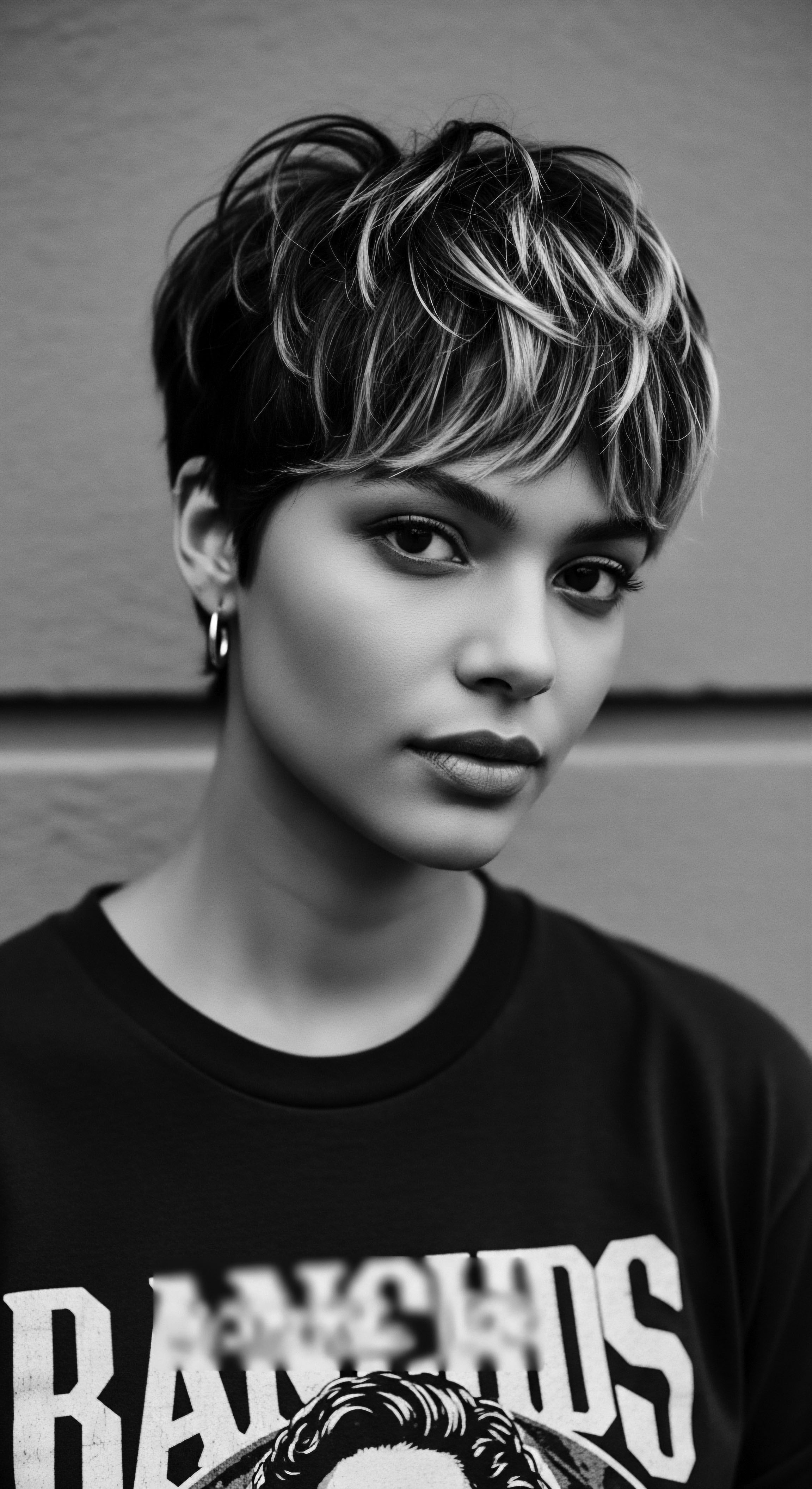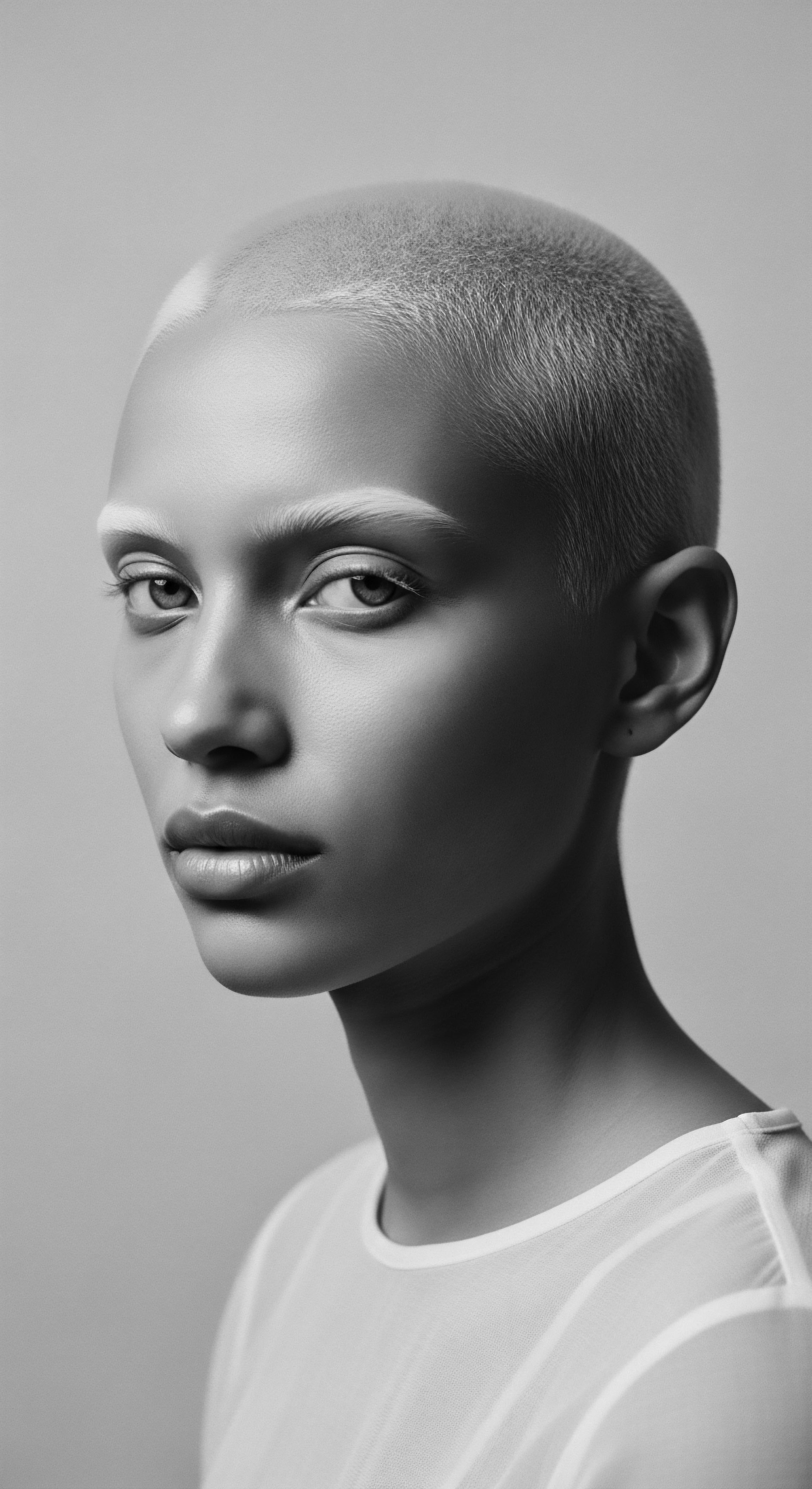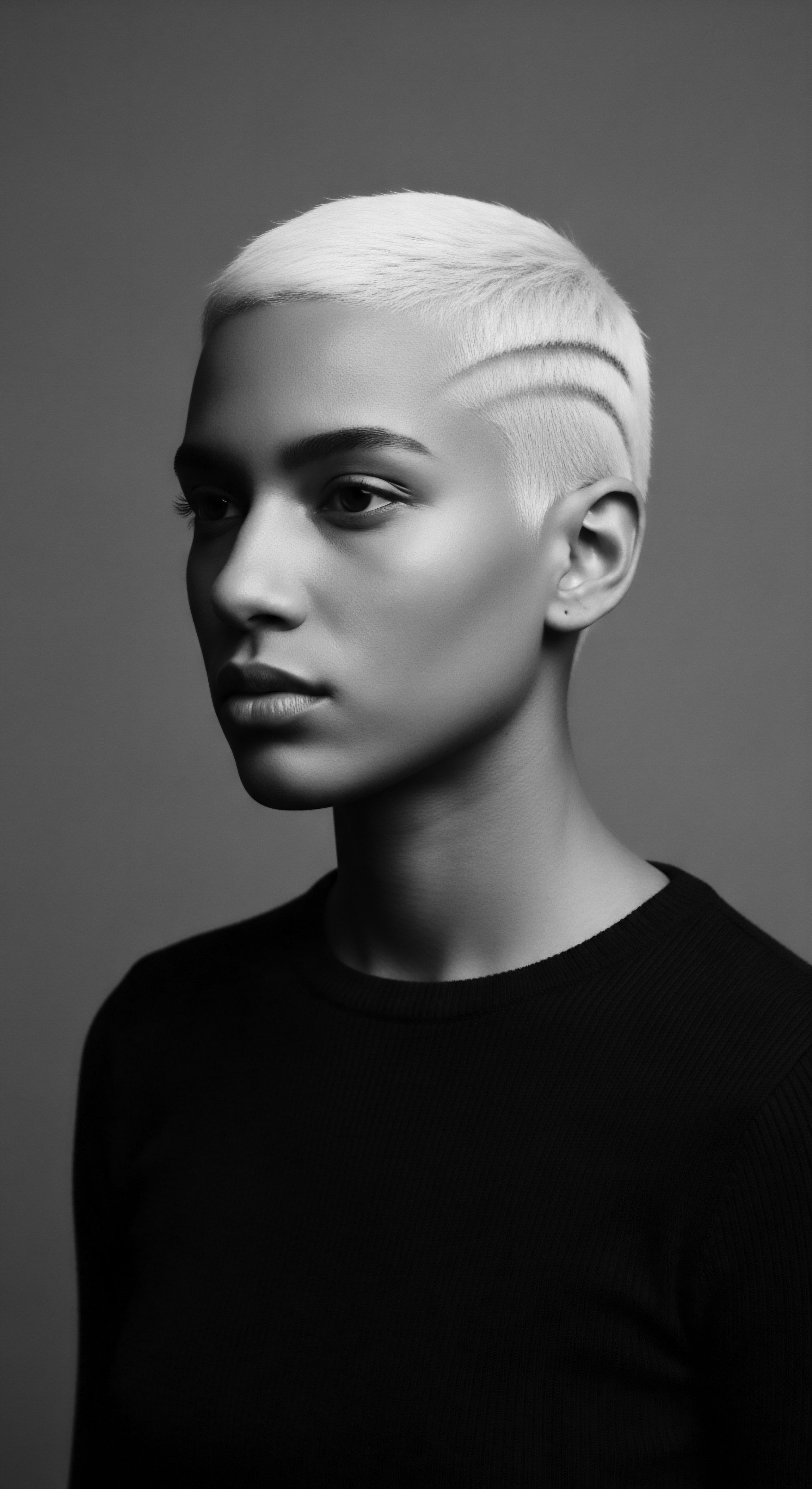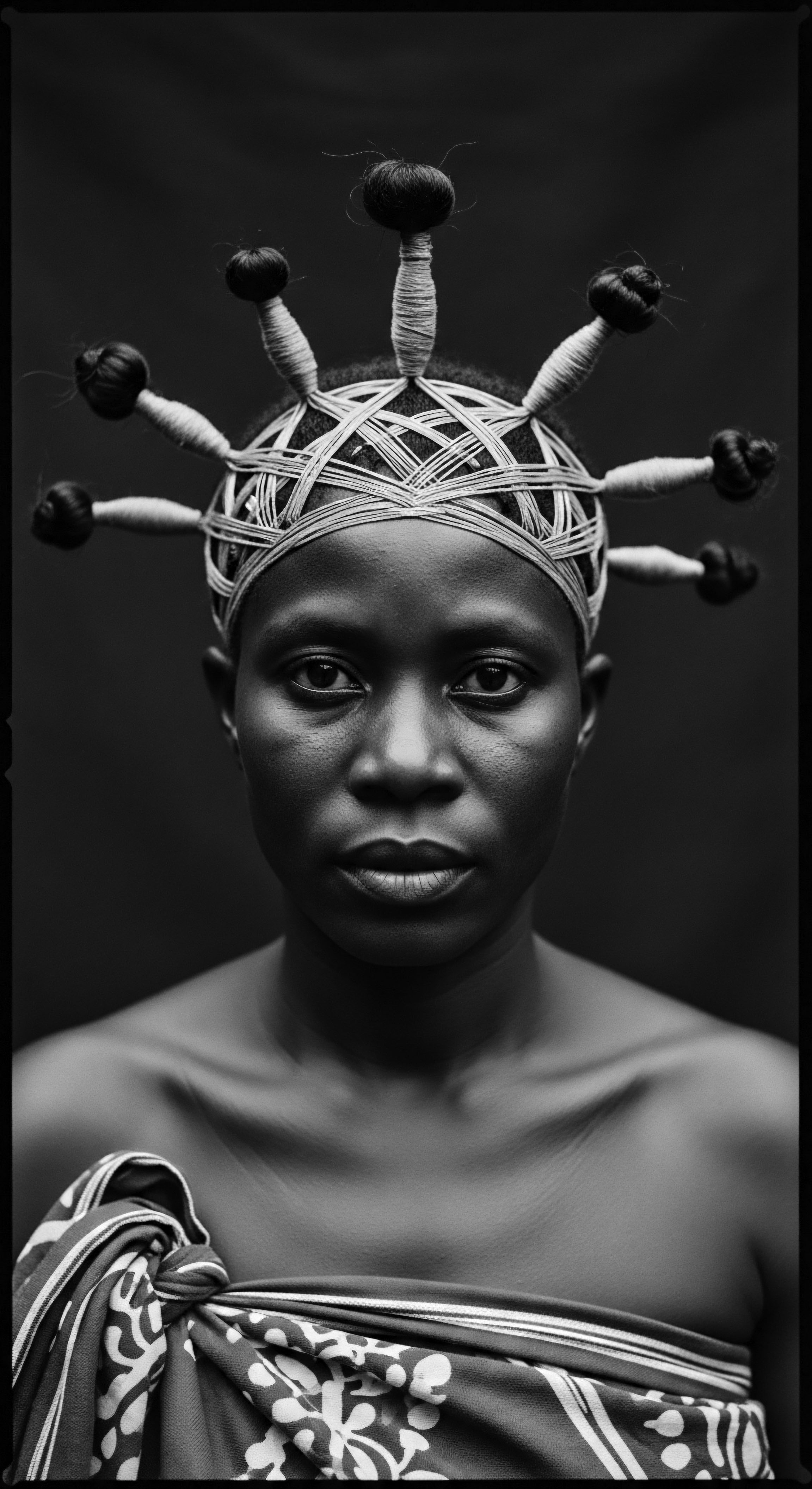
Roots
Across generations, from the sun-drenched savannas to vibrant village squares, a quiet yet powerful understanding of hair has been passed down. It is a whisper of wisdom, an ancestral cadence echoing through every strand, particularly those that coil and spiral with unique grace. This understanding recognizes textured hair not merely as a physiological outgrowth but as a living archive, bearing the marks of time, lineage, and resilience. For centuries, the earth herself provided potent allies in this journey of care.
Among these, the unassuming nut of the shea tree, the Vitellaria paradoxa, yields a butter that holds stories within its creamy depths—stories of shielding, of sustaining, of deep reverence for hair’s natural state. It is within this sacred context that we ponder a fundamental question ❉ how does shea butter, a gift from ancient lands, forge a protective barrier upon textured hair, preserving its inherent strength and beauty?
The answer resides in both the elemental biology of the hair shaft and the profound knowledge accumulated through ages of traditional practice. Our textured hair, with its unique structure, often possesses a greater propensity for moisture loss compared to straighter types. The very twists and turns along the hair shaft create points where the cuticle, the hair’s outermost protective layer, can lift, exposing the inner cortex to environmental assaults. Shea butter, a substance revered across West Africa, intervenes in this delicate interplay.
Its composition, a rich symphony of fatty acids and non-saponifiable elements, creates a substantive, yet breathable, occlusive layer on the hair’s surface. This external sheath works like a natural cloak, sealing in precious hydration while repelling external aggressors.

Ancestral Understanding of Hair’s Inner World
Before the advent of microscopes, ancestral custodians of hair knowledge possessed an intuitive grasp of its delicate nature. They observed how sun, wind, and daily activities could render hair brittle, prone to breakage. This observation led to the development of rituals centered around ingredients that offered tangible protection. The cuticle , the hair’s outermost armor, comprises overlapping cells, much like scales on a fish.
On highly coiled or curled strands, these scales may not lie as flat, leaving subtle openings. It was recognized, through trial and profound connection to natural resources, that certain plant derivatives could smooth and fortify this outer layer. Shea butter was one such discovery, its unctuous texture signaling its capacity to coat and seal.
Shea butter forms a resilient cloak, sealing moisture within textured hair and standing guard against environmental elements.
The historical use of shea butter in various West African communities speaks volumes. For generations, women in regions like present-day Ghana and Burkina Faso have utilized its rich consistency, often warm, rubbed into hair after washing with traditional soaps derived from plant ashes. This practice, passed through maternal lines, wasn’t just about softness; it was about creating a resilient shield against the harsh sun, dust, and drying winds of the savanna.
One compelling historical account from the 18th century, detailed by Mungo Park in his ‘Travels in the Interior Districts of Africa’ (1799), describes indigenous populations preparing a thick, unctuous butter from the ‘shea-tree’ which they used to anoint their bodies and hair, a practice likely serving both cosmetic and protective purposes in their environment. (Park, 1799) This historical insight underscores the long-held understanding of shea butter’s protective qualities, even if the precise scientific mechanisms were yet to be articulated.

How does Shea Butter Interact with Hair’s Protein Structure?
Beneath the cuticle lies the cortex , the hair’s primary bulk, composed of keratin proteins. While shea butter primarily acts externally, its ability to condition the cuticle indirectly impacts the cortex. When the cuticle is smoothed and flattened by the butter’s lipid layer, it reduces friction between individual strands, minimizing mechanical damage that can otherwise compromise the protein integrity within. The fatty acids, particularly stearic acid and oleic acid , present in shea butter possess a notable affinity for the hair’s surface.
This allows them to adhere, creating a hydrophobic film. This film prevents water from excessively entering or exiting the hair shaft. For textured hair, which can be particularly sensitive to humidity fluctuations (leading to frizz or extreme dryness), this moisture-balancing act is paramount for maintaining structural soundness.
Consider the ancestral wisdom of applying shea butter to hair before venturing out for daily chores or long journeys. This wasn’t a casual gesture; it was a deliberate act of safeguarding. The butter provided a physical barrier, deflecting environmental aggressors such as ultraviolet radiation and particulate pollutants that can degrade hair’s protein bonds over time. This ancient foresight, validated by contemporary scientific understanding of lipid barriers, highlights a profound connection between traditional practice and the inherent needs of textured hair.
| Traditional Protectant Shea Butter ( Ori in Yoruba) |
| Ancestral Application Melted and massaged into hair and scalp; often blended with herbs. |
| Protective Mechanism (Heritage View) Forms a physical shield against sun, dust, and drying winds. Adds weight and sheen. |
| Modern Scientific Link to Protection Rich in fatty acids (oleic, stearic) that create an occlusive, hydrophobic film, reducing transepidermal water loss. Contains antioxidants (vitamins A, E). |
| Traditional Protectant Palm Oil |
| Ancestral Application Applied to hair as a conditioning and styling agent. |
| Protective Mechanism (Heritage View) Conditions and softens hair, reducing brittleness and breakage from manipulation. |
| Modern Scientific Link to Protection Contains saturated fatty acids (palmitic acid) that can coat the hair shaft, providing lubrication and a mild barrier. |
| Traditional Protectant Kukui Nut Oil (Hawaii) |
| Ancestral Application Used for hair conditioning, especially after sun exposure. |
| Protective Mechanism (Heritage View) Soothes scalp, conditions hair, thought to restore moisture. |
| Modern Scientific Link to Protection Rich in linoleic and linolenic acids, which can penetrate hair shaft, offering conditioning and some barrier support against moisture loss. |
| Traditional Protectant These ancestral practices showcase a deep-seated understanding of how natural emollients can shield hair from the environment. |

Ritual
The application of shea butter to textured hair transcends mere product use; it becomes a ritual, a deliberate act deeply entwined with historical styling practices and the preservation of hair heritage . Across the diaspora, from the intricate braids of the Fulani to the sculpted coiffures of ancient Benin, styling was not merely aesthetic. It was a language, a statement of identity, status, and community affiliation.
Shea butter, often warmed and softened by hand, was an indispensable partner in these processes, its presence signaling a dedication to both beauty and hair health. It was not simply a cosmetic; it was a tool, a medium through which elaborate styles were crafted and sustained, acting as a silent guardian.
The efficacy of shea butter in creating a protective barrier becomes particularly apparent in the context of traditional protective styling. Styles such as cornrows, twists, and locs were not only culturally significant but also served a practical purpose ❉ to minimize manipulation and exposure to environmental stressors, thereby guarding the hair. Shea butter supported these styles by lending pliability to the strands, making them easier to handle, and by coating them with a resilient layer.
This coating worked to reduce friction within the braids or twists themselves, preventing the subtle, persistent erosion of the hair’s outer cuticle that can occur over time. The butter’s presence allowed these protective styles to truly serve their purpose, extending their longevity and the health of the hair underneath.

Supporting Complex Styling Traditions
Imagine the hands of an elder, practiced and knowing, meticulously braiding or twisting a young one’s hair. Each section would be treated with care, often with a whisper of shea butter to smooth the strand, to ease its passage through nimble fingers. This wasn’t merely about aesthetics; it was about ensuring the integrity of the hair against the rigors of daily life. The butter, with its slightly viscous consistency, served as a natural lubricant, reducing tensile stress on the hair during styling.
This lubrication is a quiet yet powerful protective mechanism, as it prevents the microscopic tears and abrasions that can compromise the hair’s surface. Without such a barrier, the constant friction of intertwining strands could lead to significant cuticle damage and, ultimately, breakage.
Shea butter’s long presence in traditional styling rituals highlights its enduring capacity to protect and strengthen hair.
The role of shea butter in maintaining the integrity of hair within protective styles also extends to its ability to repel dust and environmental pollutants. Historically, communities lived in close relationship with their environment, where dust, smoke from cooking fires, and other airborne particulates were daily realities. A layer of shea butter on the hair acted as a physical shield, forming a film that these particles struggled to adhere to directly.
Instead, they would settle on the butter, which could then be cleansed away, leaving the hair shaft beneath relatively untouched. This was a form of passive protection , a continuous, silent defense against elements that could otherwise dry out and degrade the hair over time.

How Did Traditional Tools Utilize Shea Butter’s Properties?
Traditional hair care tools, often crafted from wood, bone, or natural fibers, worked in concert with shea butter. Combs with widely spaced teeth, for instance, would distribute the butter evenly along the hair shaft without causing undue tension. The butter’s ability to create a smooth, lubricated surface meant that these tools could glide through hair, minimizing snagging and reducing the potential for breakage that often accompanies manipulation of dry, unprotected textured hair. This interplay between tool and treatment was not accidental; it was a product of generations of observation and refinement, a testament to ancestral ingenuity in preserving hair health.
Consider the ancestral practice of periodic re-application. Even within protective styles, the hair would periodically receive fresh applications of shea butter, particularly along the length of the braids or twists and at the ends, which are the oldest and often most vulnerable parts of the strand. This continuous re-fortification ensured that the protective barrier remained intact, constantly replenishing the lipid layer that guarded against moisture loss and environmental harm. This meticulous attention to ongoing care, supported by the readily available and effective shea butter, speaks to a deep cultural value placed on the longevity and vitality of textured hair.
- Fula Braids ❉ These intricate styles, often adorned with cowrie shells and silver, received a generous application of shea butter to enhance their longevity and shield the hair from the elements.
- Bantu Knots ❉ A protective style where sections of hair are twisted and coiled into small, tight knots. Shea butter eased the twisting process and helped hold the knots, while providing a barrier.
- Dreadlocks Cultivation ❉ Historically, shea butter or similar plant fats were used to condition and maintain locs, contributing to their robustness and protecting the hair from dryness and environmental damage over many years.

Relay
The journey of shea butter, from an ancient staple in ancestral care rituals to a recognized agent in contemporary textured hair regimens, represents a relay of wisdom across generations. Its protective qualities, understood intuitively by those who first cultivated its use, are now illuminated by scientific understanding, strengthening its place in modern wellness philosophies. The efficacy of shea butter in constructing a barrier on textured hair is not merely a matter of anecdotal evidence; it rests upon a confluence of biochemical properties that reinforce its historical standing. This understanding allows us to appreciate shea butter’s role not just as a product, but as a bridge connecting past practices with present needs, honoring the continuous narrative of hair heritage .
The protective barrier shea butter forms is multifaceted, addressing several vulnerabilities common to textured hair. Firstly, its high concentration of long-chain fatty acids , notably stearic and oleic acids, allows it to effectively coat the hair shaft. This creates a hydrophobic, or water-repelling, layer. For textured hair, which often exhibits higher porosity due to its structural characteristics, this lipid layer is paramount.
It mitigates excessive water absorption from humid environments, which can lead to frizz and swelling of the hair shaft, and crucially, it reduces transepidermal water loss (TEWL) —the evaporation of moisture from within the hair. This balance of moisture is fundamental to maintaining the hair’s elasticity and preventing brittleness, particularly in harsh climates or environments.

The Lipid Layer and Environmental Defense
Beyond moisture regulation, the lipid barrier created by shea butter offers a tangible shield against external aggressors. Think of airborne pollutants, dust, and even the subtle erosive effects of daily environmental exposure. These elements, if allowed direct contact, can gradually degrade the hair’s outermost cuticle layer, leading to roughened surfaces and diminished integrity. Shea butter’s continuous film acts as a physical interceptor, a sacrificial layer that bears the brunt of these external forces, rather than allowing them to directly impact the hair fiber.
This is especially pertinent for individuals living in urban environments or areas with significant dust or atmospheric particulate matter. The ability to simply wash away this protective layer, along with the accumulated environmental debris, leaves the underlying hair strands cleaner and less stressed.
Moreover, the non-saponifiable fraction of shea butter, a unique component that includes phytosterols , tocopherols (Vitamin E) , and triterpene alcohols , contributes to its protective prowess. These compounds possess recognized antioxidant properties. While not forming the primary physical barrier, they contribute to the overall health of the hair and scalp by neutralizing free radicals, which can otherwise cause oxidative damage to hair proteins and lipids.
This subtle yet significant contribution to hair health complements the physical barrier, creating a more comprehensive defense system. It speaks to a deep, inherent intelligence within the plant itself, and to the ancestral knowledge that recognized its holistic benefits.
Shea butter’s protective action goes beyond coating, offering both physical defense and biochemical support for hair vitality.

What Makes Shea Butter Uniquely Suited for Textured Hair Protection?
The molecular architecture of shea butter makes it particularly well-suited for textured hair. The melting point of shea butter is close to body temperature, allowing it to soften and spread easily upon contact with warmth from the hands or scalp. This characteristic facilitates even distribution across the intricate curves and coils of textured hair, ensuring that every part of the strand receives adequate coverage.
Unlike lighter oils that may quickly evaporate, shea butter’s semi-solid nature at room temperature ensures a more sustained presence on the hair shaft, prolonging its protective effect. This persistence is a key factor in its historical and continued efficacy, providing consistent defense between wash days.
Consider the historical understanding that a visibly lubricated or ‘dressed’ hair was less prone to tangling and breakage. This observation aligns with the modern understanding that a smooth, coated cuticle reduces inter-fiber friction. For textured hair, prone to knots and snags due to its natural curl pattern, this reduction in friction is a monumental benefit.
It means less stress during detangling, less hair lost to everyday manipulation, and ultimately, a more robust hair shaft. The ancestral application methods, often involving warmth and careful massage, maximized this benefit, ensuring the butter penetrated the outer layers and created an even, continuous film.
- Fatty Acid Composition ❉ Rich in stearic and oleic acids, which create a hydrophobic layer on the hair.
- Non-Saponifiable Matter ❉ Contains antioxidants like vitamins A and E, and phytosterols, offering a secondary line of defense against oxidative stress.
- Melting Point ❉ Close to body temperature, allowing for smooth, even distribution over textured hair’s unique topography.
- Occlusive Properties ❉ Forms a semi-permeable film that reduces moisture loss while allowing the hair to breathe.

Reflection
In the quiet moments of caring for textured hair, a profound connection to generations past is felt. The simple act of applying shea butter, a gesture repeated countless times across vast landscapes and historical eras, transforms into a sacred conversation with ancestral wisdom . It is a recognition that the principles of care, of shielding and nourishing, were understood long before laboratories could isolate compounds or quantify moisture loss. The journey of shea butter, from the ancient communal pots of West Africa to the thoughtfully designed routines of today, is a testament to an enduring heritage of self-possession and deep respect for one’s inherent beauty.
Each application of shea butter is a reaffirmation of a legacy—a legacy of resilience, of ingenuity, and of a profound understanding of the natural world. It is a tangible link to the mothers, grandmothers, and grandfathers who guarded their hair, not out of vanity, but out of a knowing that hair was a conduit of identity, a marker of spirit, and a canvas for cultural expression. The protective barrier shea butter creates is more than a physical shield; it is a symbolic one, guarding against the narratives that sought to diminish textured hair, allowing its inherent strength and radiant truth to stand unbound. In this act, we honor the Soul of a Strand, recognizing that true beauty resides not in conformity, but in the celebration of our unique, inherited helix.

References
- Park, Mungo. Travels in the Interior Districts of Africa. W. Bulmer and Co. 1799.
- Akihisa, T. Kojima, N. Kikuchi, T. Yasukawa, K. & Takido, M. (1996). Anti-inflammatory and chemopreventive effects of triterpene cinnamates and acetates from shea fat. Journal of Oleo Science, 45(1), 23-28.
- Elias, M. & Van Praag, M. (2000). Shea Butter ❉ A Natural Resource for Rural Development. International Centre for Research in Agroforestry (ICRAF), Nairobi.
- Badifu, G. I. O. (1992). The use of shea butter in cosmetic products. Journal of the American Oil Chemists’ Society, 69(12), 1251-1254.
- Goreja, W. G. (2004). Shea Butter ❉ The Nourishing Power of Africa’s Gold. TNC Publishing.
- Kringel, M. A. (2010). The chemistry of hair. Journal of Cosmetic Science, 61(1), 47-75.
- Robins, M. (2001). Hair ❉ A Cultural History. Verso.
- Wild, D. (2000). Hair ❉ The Anthropology of Hair. Berg.
